Biology Exam 4
1/125
There's no tags or description
Looks like no tags are added yet.
Name | Mastery | Learn | Test | Matching | Spaced |
|---|
No study sessions yet.
126 Terms
nervous system
receives and integrates information
initiates rapid responses to that information
the human nervous system enables us to think, remember, empathize, write poetry, make music, and enjoy sensations
neurons
cells in the nervous system
can transmit signals from one part of the body to another quickly
peripheral nervous system (PNS)
nerves and nervous tissues
the PNS gathers information from the external and internal environment and sends it on to the CNS
central nervous system
brain and spinal cord
processes PNS information and often generates a return signal to be delivered by the PNS to the body parts that will execute the signal
neuron
a specializes cell that can receive and transmit information from many different types of cells
dendrites and axons
dendrites: that receive signals from adjacent cells
axons: which specialize in transmitting signals to other cells
myelin
an insulating sheath made of a fatty material produced by glial cells which surround the axons
myelinated axons can carry signals more rapidly than unmeyelinated axons
nerve
made up of many individual neurons bundled together with supporting cells, blood vessels, and connective tissue to form a major communication pathway
the peripheral and central nervous system exchange information
sensory neurons from the PNS convey sensory input to interneurons in the CNS
interneurons process and may send them directly to the motor neurons for immediate action or to the brain for further processing
an interneuron may also send its output up to the brain and out to the PNS at the same time ina simultaneous flow
voluntary vs involuntary
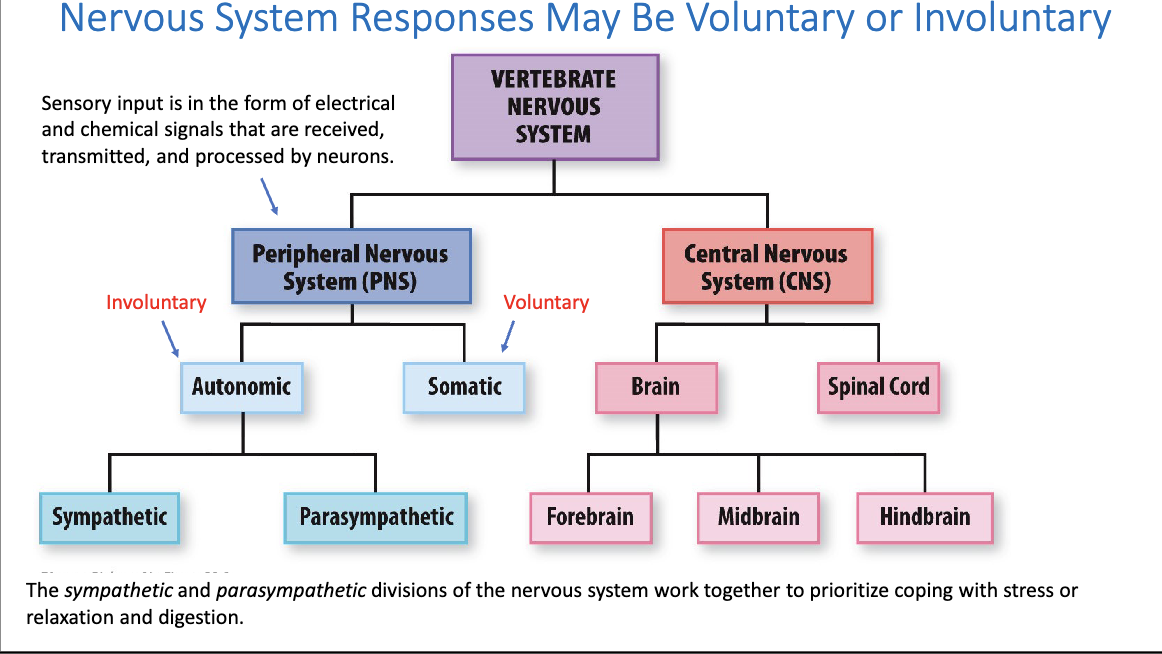
reflex arc
consists of a sensory neuron that send the message to the spinal cord
then an interneuron
and finally a motor neuron that creates a response in the body
action potential
a pulse of electrical disturbance that travels down the length of an axon
triggers the release of chemical messengers called neurotransmitters the signal to the next cell in this line of communication
action potentials are propogated along the length of an axon
an action potential is a self sustaining electrical signal that travels away from the body of the neuron
the action potential is dependent on the positively charged ions moving across the plasma membrane
the plasma membrane is in a polarized state because there is a difference in electrical charges across the plasma membrane
the electrical charge that exists across the plasma membrane of an unstimulated neuron is known as the resting potential
a stimulus depolarizes a neuron if the flow is changed in such a way that many more positivitely charged ions are able to enter the cell
once the action potential has passed the neuron returns to its resting potential
nodes of ranvier
the site of action potentials
unmyelinated gaps between the myelin sheath
myelinated axons transmit action potentials especially rapidly
action potentials are sped up by the presence of the myelin sheath
the action potential is regenerated at each node allowing the signal strength to jump rapidly from one node of ranvier to the next
action potentials have several important features
they move along the axon in only one direction keeping the signal from being lost
remains consistently strong as it moves from one end of the axon to the other and does not weaken with distance
a strong stimulus will initiate action potentials more often but any individual action potential will be no stronger than any other it is an all or none event
synapse
a junction where the electrical signal is converted into a chemical message and relayed to the next cell
neurotransmitters
the chemical messangers
transmission of the information at a synapse takes place across a tiny fluid filled gap between two cells called the synaptic cleft
forebrain
cerebrum, thalamus, hypothalamus
cerebrum
divided into two hemispheres
bundles of axons carry information between the right and left hemispheres
cerebral cortex
highly folded part
responsible for our capacity to talk, calculate, create art, and conciously sense the world around us
thalamus
determines which of the sensory signals coming from the spinal cord should go to the conscious perception centers in the cerebrum
hypothalamus
helps integrate the nervous system and the endocrine system
the cerebrum is divided into 4 major lobes - each of the hemispheres of the cerebrum has four major lobes
frontal lobe: reasoning and problem solving
parietal lobe: speech, taste, reading, and sensation
occipital lobe: vision
temporal lobe: sound and smell
midbrain
helps control movement involved in motivation and reward seeking behaviors
helps maintain muscle tone and sends some sensory data to higher brain centers in the forebrain
hindbrain
coordinates information dealing with breathing rhythms, blood pressure, heart rate, and balance among many other functions
midbrain and hindbrain together make up the brain stem
sensory structures
chemoreceptors: chemicals (taste, smell)
photoreceptors: light (vision)
mechanoreceptors: physical changes (touch, hearing, proprioception (body position), balance)
thermoreceptors: moderate heat and cold (thermoreception (gradations of heat and cold)
pain receptors: injury, noxious chemicals, chemical and physical irritants (pain, itch)
electroreceptors: electrical fields (electrical sense)
magnetoreceptors: magnetic fields (magnetic sense)
chemoreceptors are found on cells that respond to chemicals such as those found on the tongue
chemoreceptors respond to chemicals
involved in two types of sensory perception: receptors on the tongue gives us our sense of taste, receptors in the nasal passages give us our sense of smell
taste involves sensing chemicals in direct contact with our bodies (food in the mouth)
chemoreceptors in the nasal passages enable us to smell
smell involves sensing molecules that are vaporized (gas forms) like the scent molecules released by a rose (for example)
mechanoreceptors
detect various kinds of physical stimuli both inside and outside the body
thermoreceptors
found in a variety of tissues including the skin, mouth, and internal organs
activated by temps in the moderate range
pain receptors
located on just about every tissue type inside and on the surface of the body and detect different types of noxious stimuli
activated by extreme temps
photoreceptors: vision
light sensitive pigment is required to sense light and dark
all image forming eyes have two common features: the light gathered from photoreceptor cells is focused to a single point in the array of photoreceptors, the photoreceptor cells convert light energy into nerve impulses that are sent by sensory neurons to the brain for processing
forming images requires a way to focus light
single lens eye focuses incoming light through a lens to the retina at the back of the eye
the pupil is an adjustable opening that controls the amount of light entering the eye
the retina is a sheet of photoreceptors that converts the light stimuli into nerve impulses
all vertebrates have a single lens eye
the human retina has two classes of photoreceptor cells called rods and cones that contain light sensitive pigments
rods: enable us to see images in shades of gray in dim light
cones: function best in bright light and transmit information in color
fovea
an area of densely packed rods and cones in the back of the human eye
allows us to form sharp colorful images of whatever is in the center of our view
herbivores eyes
have eyes that tend to be situated far apart on either side of the head
allowing them the wildest possible panoramic view
most predators eyes
have eyes situated close together on the front of the head to enable both eyes to focus on the same point at the same time
this gives them good depth perception
hearing
involves detecting waves of pressure change in air which spread out in all directions from the sound source
sound waves
diminish in intensity as they travel which explains why distant sounds are softer than the same sounds originating nearby
pitch
the number of pressure changes per second is known as the sounds frequency or what we perceive as pitch
loudness
reflects the intensity of the pressure changes in the sound waves
hearing process
the outer ear consists of the pinna which is the cartilaginous part that we identify as the external ear and the auditory canal
the outer ear is designed to concentrate sounds energy on the eardrum
the eardrum converts sounds energy into physical movements by vibrating in response to rapid changes in air pressure
structure of the human ear
the eustachian tube equalizes pressure differences between the middle and outer ears
in the middle ear vibrations from the eardrum are transmitted to a second membrane by three tiny bones which then channel them to the chochlea
in the cochlea are many organ of corti where vibrations of a basilar membrane are converted by mechanoreceptors into a pattern of nerve impulses
proprioceptors
specialized mechanoreceptors that respond to stretching of or pressure on muscles, tendons, and joints to inform us of the position of our bodies in space
vestibule
a structure in the ears helps us maintain our sense of balance, sense up from down, and detect head movements
semicircular canals
located in the vestibule and help us detect head movements
locomotion
ability to move from place to place
accomplished through skeletal structures and muscles
the skeleton
supports the body
gives it shape
protects soft tissue and organs
axial skeleton
supports and protects the long axis of the body
includes the skull, ribs, and a long bony spinal column
appendicular skeleton
makes movement possible
includes the arms, legs, and pelvis
compact bone
forms the hard white outer region
spongy bone
lies inside the compact bone
osteocytes
specialized bone cells that surround themselves with a hard nonliving mineral matrix composed largely of calcium and phosphate compounds
marrow
a tissue inside the cavity of bone that produces blood cells or stores fat
osteoclasts
special bone cells that remove tissue from the bone
osteoblasts
special bones cells that restore bone tissue
cartilage
dense tissue that combines strength with flexibility
made up predominantly of extracellular material containing collagen (an extremely pliable protein)
thin and lacks a blood supply therefore living cells in cartilage depend on diffusion to acquire oxygen and nutrients and remove wastes
joints
junctions in the skeletal system that let the skeleton move in specific ways
ligaments
flexible bands of connective tissue
join bone to bone to help hold a joint together
tendons
collagen rich
connect muscle to bone
how joints work
two pairs of ligaments connect the femur to the lower leg bones (prevents sliding along the joint surface when the knee bends)
knee joint: allows the lower leg to swing forward and back like a hinge but not side to side thereby providing both motion and stability
synovial sac
made of sheets of tissue that create a sac containing lubricating fluid that reduces friction between the two bony surfaces
how muscles work
muscle tissue is unique to animals and provides the power necessary for movement
muscle has the ability to contract and relax unlike any other tissue
a muscle fiber is made up of several muscle cells that fused together
each muscle fiber contains myofibrils which contain proteins that can contract against each other
muscle tissue can generate force by contracting
myofibrils are organized into contractile units called sarcomeres which are visible as bands when seen through a microscope
each sarcomere consists of actin filaments and myosin filaments made of proteins that attach to a z disc at each end
myosin and actin filaments interact to create a muscle contraction that produces force
skeletal and cardiac muscles have a banded appearance
most skeletal muscles are under voluntary control executing movements we choose to make
cardiac and smooth muscles are under involuntary control
cardiac muscle
found only in the heart
contains fibers that are joined by interconnecting branches that help them produce the coordinated contractions of the heart
smooth muscle
lacks the bands associated with other muscle types
its contractions are generally involuntary
smooth muscle lacks the banded appearance
the contractile proteins of smooth muscle cells interlink the plasma membrane on opposite sides of these spindle shaped cells and slide together producing a squeezing action
smooth muscle is also found in the digestive tract, the walls of blood vessels, the respiratory tract, and the urinary bladder
muscles that move body parts often work in opposing pairs
muscles that move limbs and other body parts are arranged in opposing pairs so that the contraction of one causes the other to relax
the triceps and biceps are an example of opposing pairs that work together to move the arms
thick muscles are stronger than thin muscles
all animals have essentially identical sarcomeres with the same actin and myosin molecules arranged in much the same pattern
strength differences among species and individuals depend almost entirely on the cross sectional area of the muscles
the greater the cross sectional area or thickness of the muscle the more muscle fibers it contains and the greater the contractile force the muscle can generate
comparing skeletons
animals have different skeletons but all have two basic functional features: stiff structures that maintain shape, joints that let the stiff parts of the skeleton move relative to one another
most skeletons are strengthened by tissues with a stiff extracellular matrix: hardened minerals (calcium salts), tough proteins (cartilage, collagen), carbohydrates (exoskeletons/chitin)
chitin
tough polysaccharide often interlinked by proteins
forms the exoskeletons of arthropods
hydrostat
many invertebrates rely on this type of structure for their skeleton
consisting of a fluid filled compartment surrounded by elastic and muscular tissue
many invertebrates depend on hydrostatic skeletons for structure and movement
fluid pressure within the body chamber gives shape to the bodies of soft bodied animals
movements of body parts powered by muscle contractions
relaxations exerted against pressurized fluid in the body cavity
endoskeleton
support tissues lies inside the body
humans and other vertebrates
exoskeleton
an external skeleton surrounds and encloses the soft tissues it supports
many invertebrates, lobsters, insects, etc.
provide a protective armor and prevent moisture loss in terrestrial animals
must be shed for animal growth
mixing of muscle fibers
two main types: slow (type 1), fast (type 2)
they differ in how fast they respond to the nerve impulses that trigger contractions and how long they can sustain a muscle contraction
different muscles have a different mix of slow and fast fibers depending on the main function of the muscle
the mix is also determined by genetics and affected by training
athletes in strength sports tend to have a high proportion of fast fibers while runners have many slow fibers
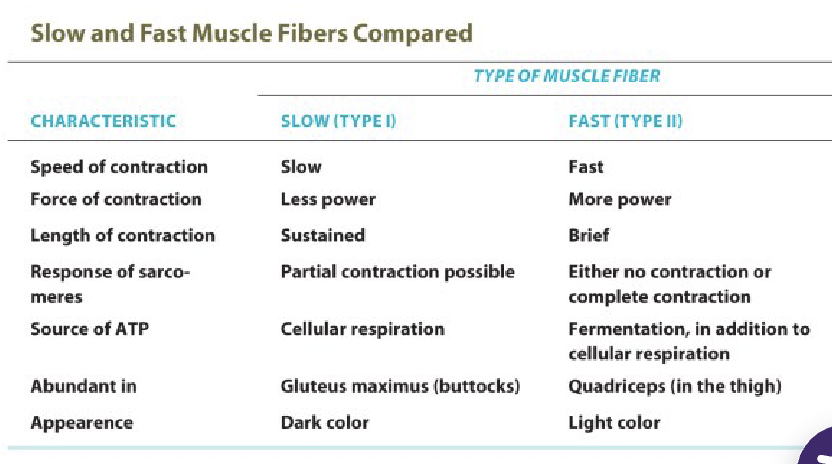
pathogens
disease causing agents and can be found on almost any surface we touch
include viruses, bacteria, and protists, some fungi, and multicellular animals
as pathogens mutate different genotypes or strains evolve
host
the individual that becomes infected by a pathogen
immune system
protects against most infectious agents can also remove abnormal cells and scavenge dead ones
external defenses
the surface of the body are the first line of defense (non-specific)
barrier defenses: the protective layers of tissue on those surfaces of the body that come in direct contact with the environment also include chemical environments
internal defense system
innate immune system: functions as the second line of defense (non-specific), features biochemical weapons and immune cells always ready
adaptive immune system
responds in a highly specific manner using specialized defense cells
immune memory that remembers a first encounter with a specific strain of pathogen and mobilizes a speedy and targeted response to a repeat infection by the same strain of pathogen
barrier defense
physical and chemical barriers on body surfaces that come into contact with the environment
internal defenses must distinguish self from nonself
sometimes a pathogen breaks through the external defense systems
must have a way of recognizing the invader as non-self
cell surface markers: designated as self by the immune system, all other proteins and carbohydrates are likely to be perceived as non-self
antibody mediated immunity
uses antipathogen protein complexes called antibodies made by white blood cells called B cells
cell mediated immunity
relies on white blood cells called T cells to attack invaders, body cells harboring invaders, and other abnormal cells in the body such as cancer cells
key immune cells of the innate and adaptive immune systems
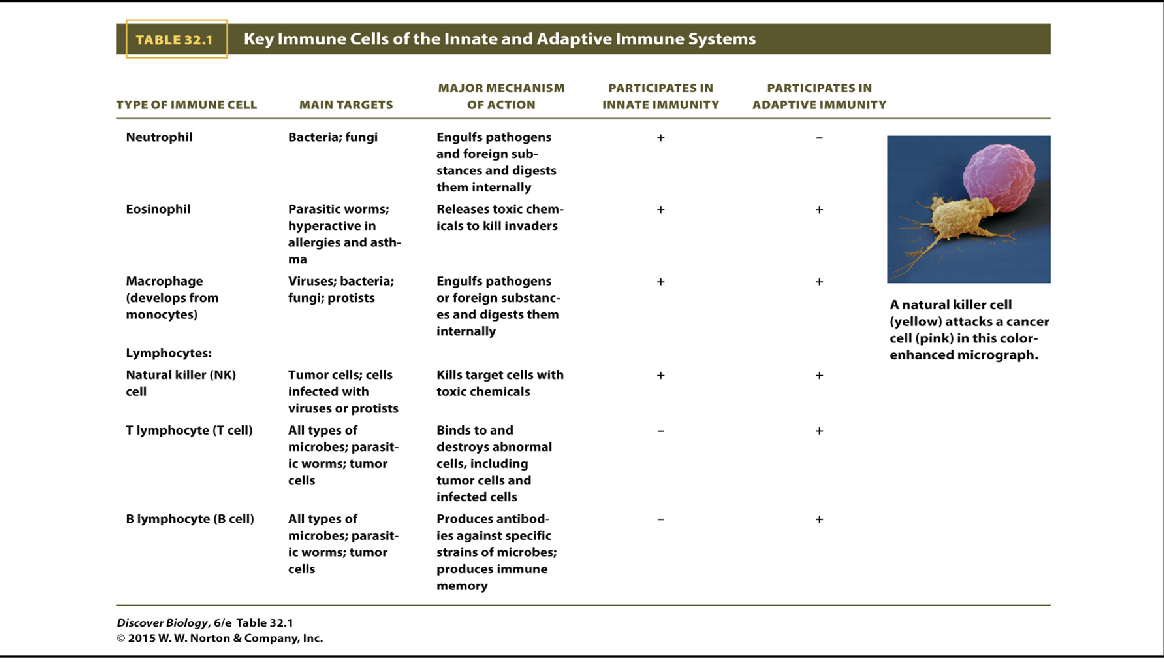
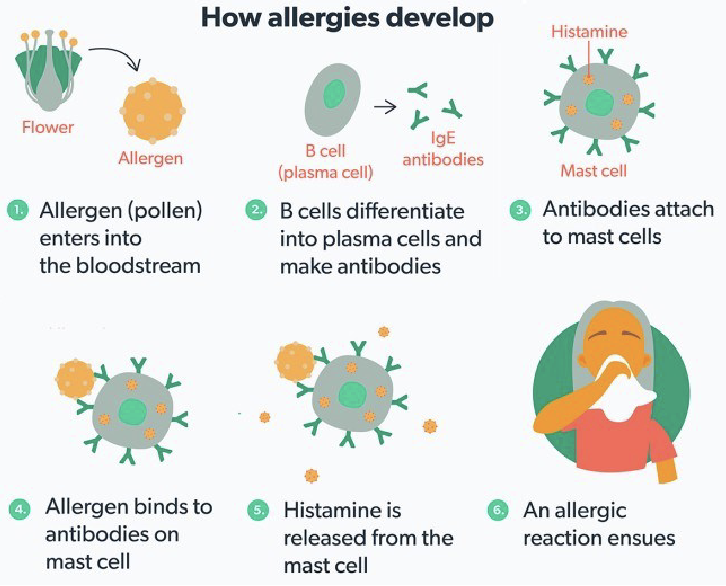
allergies and autoimmune diseases
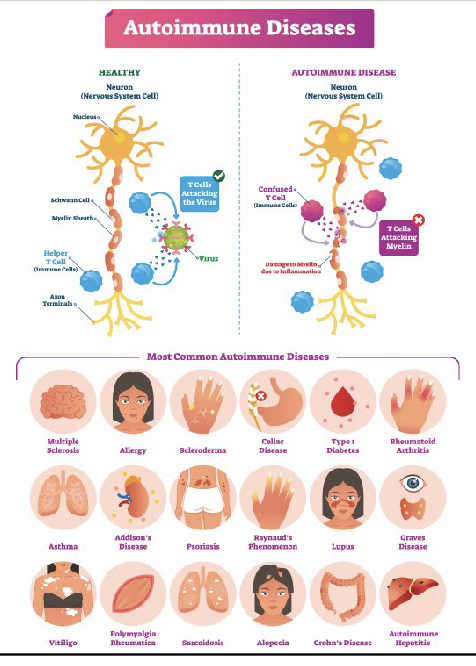
lymphatic system
a closed network of vessels
tissue pockets called lymph nodes
tissue patches
special organs that include the thymus and the spleen
lymph
fluid that circulates through the lymph vessels
lymphatic ducts
a network of tubes where defensive proteins, white blood cells, and interstital fluid are collected
will return fluid back to the circulatory system
lymph nodes
contain large numbers of white blood cells such as lymphocytes that trap bacteria, viruses, and foreign proteins
first line of defense
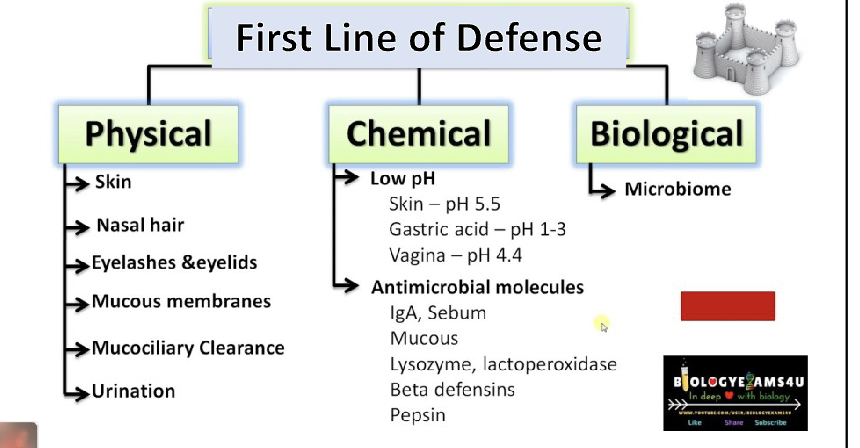
second line of defense
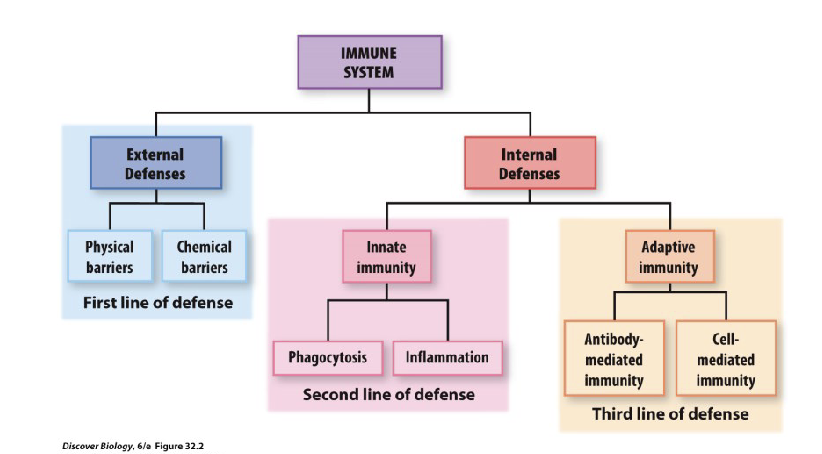
phagocytes
white blood cells
include macrophages and neutrophils destroy invading cellular organisms by engulfing their target in a process called phagocytosis
the engulfed pathogen is confined to a membrane enclosed compartment where it is chemically broken down or walled off from other cells by encapsulation
individual phagocytes die when they are full of pathogens
inflammation
cleans up the damaged tissues and prevents the entry or spread of a pathogen
direct injury or activation by chemical signals stimulates mast cells which release histamine and other alarm signals including cytokines
innate immune system is involved in blood clots
the innate immune system is also responsible for clotting the blood to close a wound
clotting reduces blood loss and restores the integrity of external defense barriers
platelets: sticky cells fragments that circulate in the blood an interlink with the clotting proteins to form a gel-like mesh that traps blood cells
innate immunity can trigger fever
cytokines trigger the release of prostaglandins to stimulate the hypothalamus and raise the body temperature resulting in a fever
moderate fever is beneficial because it: limits growth of many pathogens, enhances phagocytosis, speeds repair of damaged tissues